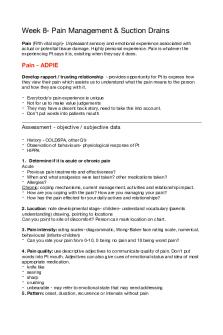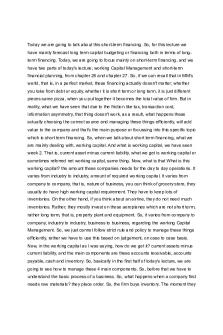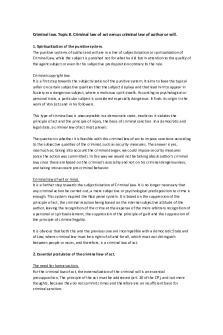Marketing CH 8 - Lecture notes 8 PDF

| Title | Marketing CH 8 - Lecture notes 8 |
|---|---|
| Course | Introduction to Marketing |
| Institution | Rutgers University |
| Pages | 5 |
| File Size | 110.8 KB |
| File Type | |
| Total Downloads | 99 |
| Total Views | 136 |
Summary
These lecture notes are really helpful and detailed, these alone are a perfect guide to understanding the concepts taught in class with so many practical examples making it so much more clear. Supplements exam preparation and retention of the material, these notes helped me get an 'A' letter grade i...
Description
Introduction to Marketing Module 7 - Chapter 8 Lecture Notes New Product Development Strategy A firm can obtain new products in two ways. One is through acquisition—by buying a whole company, a patent, or a license to produce someone else’s product. The other is through the firm’s own new product development efforts. New products are original products, product improvements, product modifications, and new brands that the firm develops through its own research and development efforts. To create successful new products, a company must understand its consumers, markets, and competitors and develop products that deliver superior value to customers. 3M estimates that 40% of its revenue comes from new products that did not exist 5 years ago. And for Apple, Ipad and iphone are new within the last 10 years and account for 70% of Apple revenue But innovation can be risky and uncertain and expensiveà 60% new products fail, 75% are developed and never launched for a variety of reasons
Major Stages in New Product Development
1. Idea Generation New product development starts with idea generation, which is the systematic search for new product ideas. A company may develop a list of 100’s or 1000’s of ideas and funnel them down to 1 or 2 that are actually launched Major sources of new product ideas include internal sources and external sources. Beyond a company’s internal R&D process, a company can pick the brains of its own people. Many companies have developed successful internal social networks and intrapreneurial programs that encourage employees to develop new product ideas. Companies can also obtain good new product ideas from any of a number of external sources, such as: distributors and suppliers- they are closer to the market and experts in their areas Competitors- benchmark comp products, reverse engineer and try to improve on the product to make their better customers themselves- reviews and customer companies and customer service logs Crowdsourcing- ideas from customers, employees, researches, the general public for new ideasà can generate powerful and unexpected ideas
2. Idea Screening The purpose of idea generation is to create a large number of ideas. The purpose of the succeeding stages is to reduce that number. Many companies require their executives to write up new product ideas in a standard format that can be reviewed by a new product committee. The write-up describes the There are 13 Modules consisting 14 Chapters in the course
Introduction to Marketing Module 7 - Chapter 8 Lecture Notes product, value proposition, the target market, and the competition. It also estimates market size, product price, development time and costs, manufacturing costs, and rate of return. The committee then evaluates the idea against a set of general criteria. R-W-W, that is, “real, win, worth doing,” refers to a new product screening framework that asks three questions: First, Is it real? Is there a real need and desire for the product and will customers buy it? Is there a clear product concept and will such a product satisfy the market? Second, Can we win? Does the product offer a sustainable competitive advantage? Does the company have the resources to make such a product a success? Finally, Is it worth doing? Does the product fit the company’s overall growth strategy? Does it offer sufficient profit potential? The company should be able to answer yes to all three R-W-W questions before developing the new product idea further.
3. Concept Development An attractive idea must be developed into a product concept. In concept development you are developing one of those new product ideas into alternative product concepts. What are you aiming to do: Find out how attractive each concept is to customers Choose the best one to advance in the NPD process Why do we test alternative product concepts? We want to look at slightly different versions of a product (different features, price points, styling) to get a sense of what is preferred with consumers as we will engage in concept testing. 3 key terms that we need to distinguish: A product idea is an idea for a possible product that the company can see itself offering to the market. A product concept is a detailed version of the new product idea stated in meaningful consumer terms. Product image is the way consumers perceive an actual or potential product. Concept testing calls for testing new product concepts with groups of target consumers. The concepts may be presented to consumers symbolically or physically. Many firms routinely test new product concepts with consumers before attempting to turn them into actual new products. For some concept tests, a word or picture description might be sufficient. A more concrete and physical presentation of the concept will increase the reliability of the concept test. After being exposed to the concept, consumers then may be asked to react to it by answering questions. The answers to such questions will help the company decide which concept has the strongest appeal.
4. Marketing Strategy Development Marketing strategy development involves designing an initial marketing strategy for introducing a new product to the market. There are 13 Modules consisting 14 Chapters in the course
Introduction to Marketing Module 7 - Chapter 8 Lecture Notes The marketing strategy statement consists of three parts: The first part describes the target market; the planned value proposition; and the sales, market-share, and profit goals for the first few years. The second part of the marketing strategy statement outlines the product’s planned price, distribution, and marketing budget for the first year. The third part of the marketing strategy statement describes the planned long-run sales, profit goals, and marketing mix strategy.
5. Business Analysis Once management has decided on its product concept and marketing strategy, it can evaluate the business attractiveness of the proposal. Business analysis involves a review of the sales, costs, and profit projections for a new product to find out whether they satisfy the company’s objectives. If the projections satisfy the company objectives, the product can move to the product development stage. If the product concept passes the business test, it moves into product development.
6. Product Development If the product concept passes the business test, it moves into product development. This refers to developing the product concept into a physical product to ensure that the product idea can be turned into a workable market offering. The R&D department will develop and test one or more physical versions of the product concept. R&D hopes to design a prototype that will satisfy and excite consumers and that can be produced quickly and at budgeted costs.
7. Test Marketing If the product passes both the concept test and the product test, the next step is test marketing, the stage at which the product and its proposed marketing program are introduced into realistic market settings. Limited cities or geographic areas. Test marketing gives the marketer experience with marketing a product before going to the great expense of full introduction. It lets the company test the product and its entire marketing program—targeting and positioning strategy, advertising, distribution, pricing, branding and packaging, and budget levels.
There are 13 Modules consisting 14 Chapters in the course
Introduction to Marketing Module 7 - Chapter 8 Lecture Notes However, test marketing costs can be high, and testing takes time that may allow market opportunities to slip by or competitors to gain advantages. Alternatives to standard test markets Controlled test markets= controlled panels of shoppers and stores Simulated test markets= lab stores or simulated online shopping environments
8. Commercialization Test marketing can give you the information you need to make that final decision about launch or not Commercialization refers to introducing the new product into the market. If a company goes ahead with commercialization, it will face high costs. Remember we have discussed tide pods in some casesà $150M to launch Tide pods in the highly competitive US laundry detergent market A company launching a new product must first decide on introduction timing. If the new product will eat into the sales of other company products, the introduction may be delayed. If the product can be improved further, or if the economy is down, the company may wait until the following year to launch it. However, if competitors are ready to introduce their own competing products, the company may push to introduce its new product sooner. The company must also decide where to launch the new product, whether in a single location, a region, the national market, or the international market. Some companies may quickly introduce new models into the full national market. Companies with international distribution systems may introduce new products through swift global rollouts.
Product Life Cycle (PLC) So, after you have gone through the entire NPD process, as a company, you want this product to live forever, generate lots of revenue so you can recoup your development costs. But each product has a life cycle, impacted by many factors. This figure shows a typical product life cycle (PLC), the course that a product’s sales and profits take over its lifetime. The PLC has five distinct stages. 1. Product development begins when the company finds and develops a new product idea. During product development, sales are zero, and the company’s investment costs mount. 2. Introduction is a period of slow sales growth as the product is introduced in the market. Profits are nonexistent in this stage because of the heavy expenses of product introduction. Promotion is all about generating awareness with consumers & trial. Consumers = innovators
There are 13 Modules consisting 14 Chapters in the course
Introduction to Marketing Module 7 - Chapter 8 Lecture Notes 3. Growth is a period of rapid market acceptance and increasing profits. Competitors may start planning an entry into your space. Growing your distribution, lowering your price point, offering new & Improved product variants, Consumers = early adopters and promotion strategy is about repeat purchases – secure your share of the market 4. Maturity is a period of slowdown in sales growth because the product has achieved acceptance by most potential buyers. Profits level off or decline because of increased marketing outlays to defend the product against competition. Defending your market share. You may look to “modify the market” look to develop new products, new consumers” examples of Axe and HD looking to go after women instead of their traditionally male markets to offer an opportunity to stave off decline. Or like Crayola “modify the product” always looking to develop new products, technologies to keep the brand fresh 5. Decline is the period when sales fall off and profits drop. Profits start to decline and make a strategic decision about what to do with the brand- maintain (reposition and hope to bring it back, harvest (reduce costs so no marketing and hope sales just chug along), drop brands (sell to another company, delist, stop selling) Is a decline always the fault of the brand or brand manager. NO can be due to external factors – fax machines- what happened tech wise in offices that made fax machines obsolete?
There are 13 Modules consisting 14 Chapters in the course...
Similar Free PDFs

Marketing CH 8 - Lecture notes 8
- 5 Pages

CH 8/ Lecture 8 ANSWERS
- 13 Pages

8 - Lecture notes 8
- 21 Pages

8 - Lecture notes 8
- 21 Pages

Ch 8- Social Notes - ch 8
- 2 Pages

8 Midwifery - Lecture notes 8
- 3 Pages

Taxation 8 - Lecture notes 8
- 2 Pages

Week 8 - Lecture notes 8
- 6 Pages

Dox 8 - Lecture notes 8
- 21 Pages

Lesson 8 - Lecture notes 8
- 2 Pages

Assignment 8 - Lecture notes 8
- 4 Pages

Week 8 - Lecture notes 8
- 23 Pages

WEEK 8 - Lecture notes 8
- 10 Pages
Popular Institutions
- Tinajero National High School - Annex
- Politeknik Caltex Riau
- Yokohama City University
- SGT University
- University of Al-Qadisiyah
- Divine Word College of Vigan
- Techniek College Rotterdam
- Universidade de Santiago
- Universiti Teknologi MARA Cawangan Johor Kampus Pasir Gudang
- Poltekkes Kemenkes Yogyakarta
- Baguio City National High School
- Colegio san marcos
- preparatoria uno
- Centro de Bachillerato Tecnológico Industrial y de Servicios No. 107
- Dalian Maritime University
- Quang Trung Secondary School
- Colegio Tecnológico en Informática
- Corporación Regional de Educación Superior
- Grupo CEDVA
- Dar Al Uloom University
- Centro de Estudios Preuniversitarios de la Universidad Nacional de Ingeniería
- 上智大学
- Aakash International School, Nuna Majara
- San Felipe Neri Catholic School
- Kang Chiao International School - New Taipei City
- Misamis Occidental National High School
- Institución Educativa Escuela Normal Juan Ladrilleros
- Kolehiyo ng Pantukan
- Batanes State College
- Instituto Continental
- Sekolah Menengah Kejuruan Kesehatan Kaltara (Tarakan)
- Colegio de La Inmaculada Concepcion - Cebu


